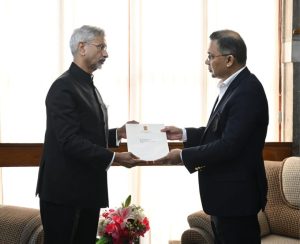
IMF MD Gita Gopinath
By Manish Anand
New Delhi, December 12: Quoting historian Niall Ferguson who argues that “we already are into the Cold War II”, managing director of the International Monetary Fund (IMF) Gita Gopinath has warned that the consequent losses could be as high as seven per cent of the GDP. She has warned that the losses would be higher for the lower income and emerging market economies.
In her speech at the 20th World Congress of the International Economic Cooperation in Colombia, Gopinath noted that the national securities now weigh higher in decisions of trade and economy. “Around 3,000 trade restricting measures were imposed last year — nearly 3 times the number imposed in 2019. Multinational firms, in their earnings’ calls, are increasingly discussing issues such as re-shoring, near-shoring, friend-shoring, and deglobalization,” said Gopinath.
The economist spoke on the US and China leading two blocks in Cold War II. “If we descend into Cold War II, knowing the costs, we may not see mutually assured economic destruction. But we could see an annihilation of the gains from open trade,” said Gopinath, recalling that since the end of the Cold War, “the size of the global economy roughly tripled, and nearly 1.5 billion people were lifted out of extreme poverty”.
Economists world over now concur that the US and China are now engaged in a ‘Great Game’ of rewriting the rules of the global supply chains as a fallout of the strategic concerns in the backdrop of the Covid-19 and the Ukraine War. While China and Russia are seen building a block consisting of countries in Central Asia, Middle East, and Latin America, the US and European nations are girding up against Beijing.
“If the global economy were to fragment into two blocs based on UN voting on the 2022 Ukraine Resolution and trade between the two blocs were eliminated, global losses are estimated to be about 2.5 per cent of GDP. But depending on economies’ ability to adjust, the losses could reach as high as 7 per cent of GDP,” argued Gopinath.
She also stated that trade growth within blocs has decreased to 1.7 per cent from 2.2 per cent pre-war, and trade between blocs has declined from 3 per cent pre-war to around -1.9 per cent. “On net, this generates 3.8 percentage point faster growth in trade within blocs as opposed to between blocs,” added the India origin economist.
Reeminding that trade between opposing blocs had collapsed from around 10-15 per cent to less than 5 per cent of global trade during the Cold War, Gopinath reminded that “the end of the Cold War coincided with the hyper-globalization period of the 1990s and 2000s (with gains in) technological innovations, unilateral and multilateral trade liberalization, and geopolitical and institutional changes all coalesced to lift economic integration to levels not seen before”. Gopinath’s warning has come close on the heels of a summit meeting between US and Chinese Presidents Joe Biden and Xi Jinping where rhetoric by two sides dominated exchange of views. However, the US is still far away from decoupling with China, as Gopinath underlined that that the power game most immediately has caused a lengthening of supply chains (China setting up shops in Mexico and Veitnam to short-circuit trade barriers imposed by the US since 2018).




